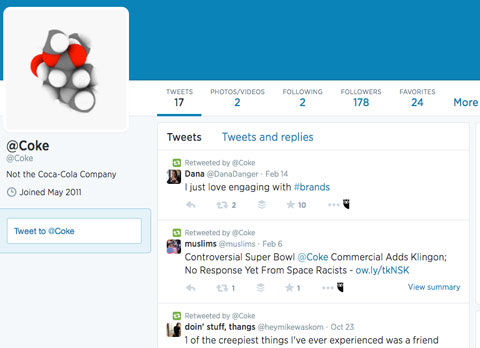 Are you struggling with the challenges of managing large-scale social media?
Are you struggling with the challenges of managing large-scale social media?
Do you run social media for a large company?
Maintaining a uniform social media presence in a complex organization is a tall order.
In this article I'll share five key elements for managing company-wide social media.
#1: Be Consistent
Managing social media in a complex organization isn't easy. There are multiple departments and divisions, multiple leaders, multiple policies–all of which can lead to confusion and frustration.

When there's no cohesive social media plan, you end up with mixed messages, duplicate accounts, redundant posts and a confused audience.
The result? The company's whole social media world crumbles down around you. OK, that may be a little dramatic, but you get the point.
In a complex organization with many departments (maybe even multiple brands and products), one person simply can't manage each of those social media accounts. At the same time, those accounts need to have consistency across the board.
#2: Lead the Way
Just like you have a CEO leading your organization, you need to have one fearless leader to oversee the organization's social media as a whole. In this article I'm going to assume that's you.
For the sake of explanation, let's look at your company-wide social media efforts as a “region,” and as the leader you are the “regional social media manager.”
You oversee the entire scope of your organization's social media and should be in charge of managing the overall social media operations, organizing teams and setting social media policies.

Each of your team members likely represents one of many different departments (or “districts”), each with its own goals and objectives. These team members are your “district social media managers.”
Choosing your team of district managers is important because it's the foundation for the rest of your social media efforts.
Get World-Class Marketing Training — All Year Long!
Are you facing doubt, uncertainty, or overwhelm? The Social Media Marketing Society can help.
Each month, you’ll receive training from trusted marketing experts, covering everything from AI to organic social marketing. When you join, you’ll also get immediate access to:
- A library of 100+ marketing trainings
- A community of like-minded marketers
- Monthly online community meetups
- Relevant news and trends updates
Include people who are familiar with the requirements, goals and objectives for each district as a critical component of social media success within a complex organization.
#3: Take Inventory
I've seen it too many times: Large organizations losing control of their social media presence. Rogue Facebook pages start popping up. Department heads create Twitter handles that basically go against everything the organization as a whole stands for.
Possibly the worst offender of all is the department or area that decides they need to have a presence on every social media channel in existence, even though they only have one person to manage them all.
Your team's first item of business is to conduct an inventory of your organization’s social media presence to determine what channels and pages are set up.
To find those accounts, ask each district manager to provide you with a list of the social media pages they deem official within their area.
But the fun doesn't stop there. Other profiles and pages may exist that departments forgot about or didn't even know about. Scour the web to determine whether there are any rogue (unofficial) sites out there that are presented as representing a department or the company as a whole.

In your search you'll probably find three things: too many social media pages, lots of pretenders and many unnecessary channels.
You're likely to find far more “official” pages (i.e., someone somewhere in the company OK'd it) than you really need. Sometimes you'll even find two or more that serve exactly the same purpose.
This typically happens when someone leaves a job and his or her replacement isn't aware of an existing page. It can also happen when someone gets tired of a current page, and instead of reorganizing and changing the page, he or she decides to leave it dormant and just create a new one.
You'll often find social media pages that weren't even commissioned by the company. Maybe a fan of your product or service decided they'd do you a favor and start a page for you. Or maybe they just wanted to capitalize on your organization's reputation.

So what's the big deal, right? The problem is that the messages posted on the page may not be in line with the message your organization wants to send—and it's not easy to get these pages taken down.

Discover Proven Marketing Strategies and Tips
Want to go even deeper with your marketing? Check out the Social Media Marketing Podcast! Publishing weekly since 2012, the Social Media Marketing Podcast helps you navigate the constantly changing marketing jungle, with expert interviews from marketing pros.
But don’t let the name fool you. This show is about a lot more than just social media marketing. With over 600 episodes and millions of downloads each year, this show has been a trusted source for marketers for well over a decade.
Sometimes you get lucky. You can find and reach the page owner, who completely understands and removes the page.
Other times you run into issues like not being able to find the page owner or having to send email after email to whichever platform the offending profile is on requesting they remove the imposters.
There is a lot of red tape to get through, so be patient when you uncover something like this.
When you do find extraneous pages, evaluate whether the company really needs to be on that particular platform. Just because an employee created a company or department presence somewhere doesn't mean you need it.
Some specific social media channels are more effective than others for reaching your audience. So if your audience isn't on a channel, you don't need it.
#4: Educate the Team
Sending out a memo to your social media district managers won't be enough to get everyone headed in the same direction. You'll need to meet face to face.
Face to face? What is this crazy guy talking about? A face-to-face meeting doesn't always mean getting together in a single room—meetings can be just as effective in a virtual format. Consider Google hangouts or GoToMeeting as possible solutions.
Invite your district managers to bring along anyone on their team who will be assisting them with social media. (If space is limited, just include the managers and task them with disseminating the information to their teams.)

You have a lot of ground to cover so it's a good idea to have several meetings instead of trying to convey everything in one fell swoop.
As the regional manager, your job is to get everyone on the same page regarding the company's audience, objectives, style guide, editorial calendar, individual assignments, resources and expected results.
Establish the company's target audience across the board—both high-level and micro-level—to ensure your collective team understands whom they're speaking to and can post accordingly. Be very clear about this as it affects everything else down the line.
If you don't have a social media style guide in place, work to develop one and share it with all of your district managers.
For this conversation, however, let's assume you do have one. Prior to the meeting, request that all attendees read the guide thoroughly. At the meeting, you can discuss the document and answer questions to bring home the importance of consistency.
As with any project, a calendar is essential. Definitely talk about how both the company-wide and departmental editorial calendars are set up, how to choose and schedule content, any approval processes, etc.
Obviously, each district manager and their teams have to be familiar with their assigned roles on both the overall organization team as well as their department team. If they're not, you'll end up right back where you started.
In order to make assignments easy, set up a social media management system, like HootSuite, where you can create multiple users and assign each a role.

Even if you have a great team in place and everyone has individual assignments, no one can do a job effectively without the proper resources. Nothing kills productivity like not knowing where to find the content you need when you need it.
Have a content management system in place where team members can go to pull content like logos, imagery or any other material that may be helpful to them.
And, of course, establish a standard for measuring results. Determine key performance indicators, provide access to analytics programs and assign a schedule for reporting.
#5: Encourage Company Support
Tell the rest of the organization about your team's social media efforts and help generate excitement about the new initiative. Let them know about goals and objectives and encourage them to participate by sharing and commenting on updates.
Getting the people in your organization to engage with your social media channels is a highly effective method of amplifying your content. Don't miss this opportunity.
Support is directly linked to connection. Ask for suggestions or comments to gather insight and to let everyone know they're a part of the company's efforts.
Over to You
Now that you're armed with an outline for reining in the social media chaos within your complex organization, put your teams together and get started. Keep in mind that my advice is general—you'll need to adjust and adapt it for your organization—but it's a solid base to build from.
Use the tips above for taking control of your complex organization's social media efforts, creating and leading a unified team and establishing social media policies.
What do you think? Have you managed a social media team within a complex organization? Have you come across any particularly difficult issues? Tell us about your experience or leave us a question.
Wordcloud photo from Shutterstock.
Attention Agency Owners, Brand Marketers, and Consultants

Introducing the Marketing Agency Show–our newest podcast designed to explore the struggles of agency marketers.
Join show host and agency owner, Brooke Sellas, as she interviews agency marketers and digs deep into their biggest challenges. Explore topics like navigating rough economic times, leveraging AI, service diversification, client acquisition, and much more.
Just pull up your favorite podcast app, search for Marketing Agency Show and start listening. Or click the button below for more information.

